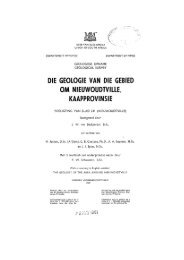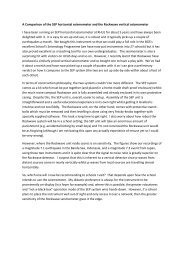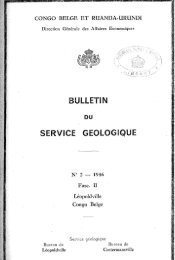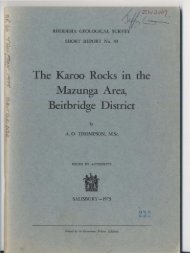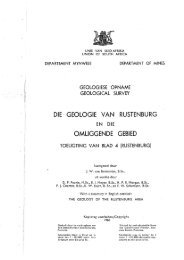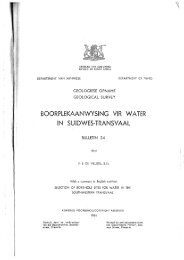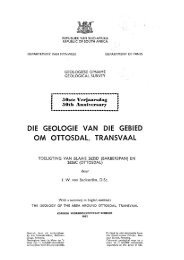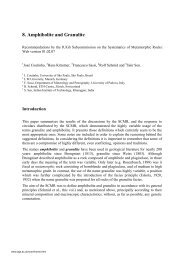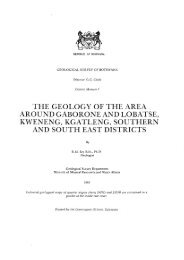Bibliography - British Geological Survey
Bibliography - British Geological Survey
Bibliography - British Geological Survey
Create successful ePaper yourself
Turn your PDF publications into a flip-book with our unique Google optimized e-Paper software.
two men one evening as they were scraping the bank and my father spoke to ‘Professor’ Woodward and<br />
asked if there had been any further finds. The answer was “I’m afraid not.”’ The reputed burial of plague<br />
victims at Piltdown is also recorded by Costello 1985, who suggests that the Piltdown skull might be linked<br />
to such burials, although the common is at some distance from Barkham Manor.)<br />
Gee, H. 1996. Box of bones ‘clinches’ identity of Piltdown palaeontology hoaxer. Nature, 381 (23 May),<br />
261‒262. (Summary of Linnean Society presidential address to be given by Brian Gardiner on 24 May in<br />
which Martin Hinton is accused of perpetrating the ‘hoax’, on the evidence of an old canvass trunk bearing<br />
his initials and containing mammalian bones and teeth, stained and carved. The report prompted reactions<br />
from Dempster 1996, Hall 1996, and Lutes 1996. For other reactions see Turrittin 2006, 21–22.)<br />
Giret, R. 2003. L’homme de Piltdown. In: Le sens de l’Evolution en question? Association des Amis de<br />
Pierre Teilhard de Chardin / Colloques Internationaux Teilhard de Chardin. Paris: Aubin Editeur, pp. 147‒<br />
150.<br />
Giuffrida-Ruggeri, V. 1913a. L’uomo attuale, una specie collettiva. Milano: Albrighi, Segati e C., 192 pp.,<br />
13 plates. (Briefly alludes to the Piltdown finds, pp. 120–121. The author is puzzled by the statement of<br />
Dawson and Woodward that they regard Piltdown as a contemporary of Heidelberg Man, and that flints of<br />
the Chellean type were found with the remains—flints of that type being considered much later in date than<br />
the Heidelberg jaw. At this stage it is impossible for him to make any further statement regarding the nature<br />
of Eoanthropus until figures, or better still, models of the remains are at his disposal. See review, probably<br />
by Arthur Keith, in Anon. 1913f.)<br />
Giuffrida-Ruggeri, V. 1913b. [Review of Dawson & Woodward 1913a]. Archivio per l’Antropologia e la<br />
Etnologia, 43, 184–186. (While accepting Woodward’s argument for a connection between the Piltdown<br />
jaw and skull, the author registers some doubts about the distinctness of the genus Eoanthropus from Homo;<br />
Spencer 1990b, 63.)<br />
Giuffrida-Ruggeri, V. 1917. La successione e la provenienza delle razze europee preneolitiche e i pretesi<br />
Cro-Magnon delle Canarie. Rivista Italiana di Paleontologia, 22 (4), 59–67. (In discussing the status of<br />
Piltdown Man, pp. 59–61, the author concurs with the views of Miller 1915 and Osborn 1916 in seeing no<br />
connection between the jaw and skull, for which he accepts the designations Pan vetus and Homo dawsoni<br />
respectively. He thinks that European anthropologists have taken a deferential position with regard to the<br />
views of Elliot Smith and Arthur Keith, yet the incompatibility between jaw and skull is clear.)<br />
Giuffrida-Ruggeri, V. 1918. Unicità del philum umano con pluralità dei centri specifici. Rivista Italiana di<br />
Paleontologia, 24 (1/2), 13–25. (Comments on ‘Homo dawsoni’, pp. 21–22. The writer remains sceptical<br />
about the claimed association between the Piltdown skull and jaw, at least until such time as a second<br />
individual is found. He had evidently not yet seen the formal paper by Woodward 1918 announcing the<br />
discovery of Piltdown II.)<br />
Giuffrida-Ruggeri, V. 1919. La controversia sul fossile de Piltdown e l’origine del philum umano.<br />
Monitore Zoologico Italiano, 30 (1/2), 7–18.<br />
Giuffrida-Ruggeri, V. 1921. Su l’origene del uomo: nuove teorie e documenti. Bologna, 267 pp., 13 plates.<br />
(Piltdown, pp. 83–89, etc.)<br />
Given, J. C. M. 1914. Recent discoveries of fossil man. Liverpool Medico-Chirurgical Journal, July,<br />
227–242. (Finds at Piltdown, pp. 234–244. With reference to the lower jaw he notes that ‘In August last<br />
the canine tooth belonging to this half of the jaw turned up, and Dr Smith Woodward informs me that by<br />
carefully putting the earth and gravel through fine-meshed sieves, he has found both the nasal bones and<br />
some small fragments of what he thinks is the vomer. The bones were all found lying close together. Mr<br />
Dawson first found one fragment by chance, some time before the others, and this had been already dug up<br />
by workmen’.)<br />
Glover, M. J. & Phillips, G. F. 1965. Chemical methods for the dating of bones. Journal of Applied<br />
Chemistry, 15 570–576. (Including a discussion of the techniques employed on the Piltdown remains)<br />
Goodwin, A. J. H. 1953. The curious story of the Piltdown fragments. South African Archaeological<br />
Bulletin, 8, no. 32 (Dec), 103–105.<br />
Gould, S. J. 1979a. Piltdown revisited. Natural History, 88, (3), 86–97. (A consideration of the historical<br />
conundrum ‘why did anyone ever accept Piltdown man in the first place?’)



